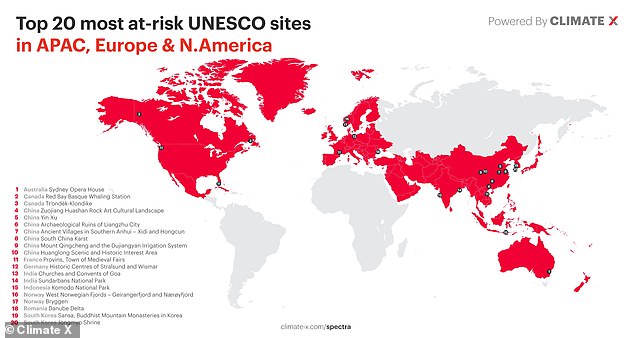They’re some of the most visited sites around the world.
But dozens of UNESCO World Heritage Sites could be wiped out by 2050 – thanks to climate change.
Researchers from Climate X used climate models to predict how flooding, coastal erosion, landslides, wind-based hazards, storms and cyclones will impact landmarks around the world.
Their analysis highlights 50 sites at risk – including four in the UK.
‘Our findings serve as a stark warning for governments, preservationists, and the global community to prioritise the safeguarding of our planet – to preserve our ancient monuments and our current assets and infrastructure- and to protect life today and into the future,’ said Lukky Ahmed, CEO and co-founder of Climate X.

They’re some of the most visited sites around the world. But dozens of UNESCO World Heritage Sites could be wiped out by 2050 – thanks to climate change

Researchers from Climate X used climate models to predict how flooding, coastal erosion, landslides, wind-based hazards, storms and cyclones will impact landmarks around the world. Pictured: The Forth Bridge in Scotland

Their analysis highlights 50 sites at risk – including four in the UK. Pictured: the archipelago of St Kilda, Outer Hebrides
UNESCO’s World Heritage list currently includes 1,223 sites, which are considered so important for our planet’s future that they should be protected forever.
In their new study, researchers from Climate X set out to understand which of these sites could perish because of climate change.
The team used Climate X’s Spectra platform, which models how climate change will affect properties, assets and infrastructure under various scenarios.
Algorithms within the platform quantify the risk from extreme weather to model the future likelihood of 16 different climate hazards — from extreme heat to tropical cyclones and flooding — across eight warming scenarios over a 100-year time horizon.

Topping the list is Indonesia’s Subak System, which is vulnerable to surface flooding, extreme heat days, and drought risk

UNESCO’s World Heritage list currently includes 1,223 sites, which are considered so important for our planet’s future that they should be protected forever. Australia’s Kakadu National Park, is at risk of surface flooding and wildfires

In their new study, researchers from Climate X set out to understand which sites could perish because of climate change. Pictured: New Lanark, Scotland
The analysis revealed 50 key sites at risk if global greenhouse gas emissions continue to rise at the current rate.
Topping the list is Indonesia’s Subak System, which is vulnerable to surface flooding, extreme heat days, and drought risk.
This is followed by Australia’s Kakadu National Park, which is at risk of surface flooding and wildfires, and China’s Quanzhou: Emporium of the World, which is at risk of drought.
Other key sites included on the list are Australia’s Sydney Opera House, the US’s Olympic National Park, Switzerland’s Swiss Alps Jungfrau-Aletsch, and Korea’s Sansa Buddhist Mountain Monasteries.
Here in the UK, four sites are included in the risk list.

Algorithms within the platform quantify the risk from extreme weather to model the future likelihood of 16 different climate hazards — from extreme heat to tropical cyclones and flooding — across eight warming scenarios over a 100-year time horizon. Pictured: Cistercian Abbey of Fontenay, France

The analysis revealed 50 key sites at risk if global greenhouse gas emissions continue to rise at the current rate. Pictured: Konark Sun Temple, India

Yorkshire’s Studley Royal Park, is most vulnerable to severe storms, according to the researchers
The Forth Bridge – a railway bridge across the Firth of Forth in the east of Scotland – and remote archipelago, St Kilda, are both vulnerable to coastal flooding, according to Climate X.
New Lanark – an 18th century mill village in Scotland – is at risk of damage from landslides, while Yorkshire’s Studley Royal Park, is most vulnerable to severe storms.
‘The potential impact of climate change on these sites is profound,’ Mr Ahmed said.
‘But it’s not just our past heritage that’s at risk – it’s our present, too.
‘While the loss of these cultural treasures – many of which have endured for millennia – would of course be devastating, it’s also vital to remember the real societal and economic impact of climate change is happening in the here and now.’

